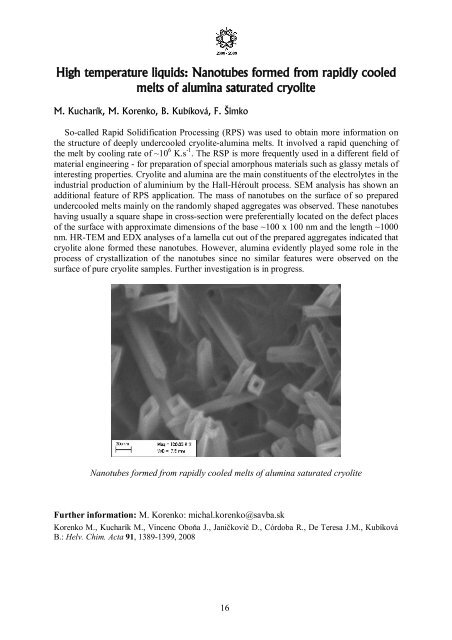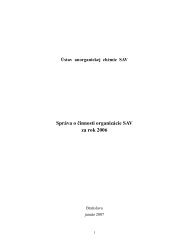Foreign Cooperating Institutions - Institute of Inorganic Chemistry ...
Foreign Cooperating Institutions - Institute of Inorganic Chemistry ...
Foreign Cooperating Institutions - Institute of Inorganic Chemistry ...
You also want an ePaper? Increase the reach of your titles
YUMPU automatically turns print PDFs into web optimized ePapers that Google loves.
High temperature liquids: Nanotubes formed from rapidly cooled<br />
melts <strong>of</strong> alumina saturated cryolite<br />
M. Kucharík, M. Korenko, B. Kubíková, F. Šimko<br />
So-called Rapid Solidification Processing (RPS) was used to obtain more information on<br />
the structure <strong>of</strong> deeply undercooled cryolite-alumina melts. It involved a rapid quenching <strong>of</strong><br />
the melt by cooling rate <strong>of</strong> ~10 6 K.s -1 . The RSP is more frequently used in a different field <strong>of</strong><br />
material engineering - for preparation <strong>of</strong> special amorphous materials such as glassy metals <strong>of</strong><br />
interesting properties. Cryolite and alumina are the main constituents <strong>of</strong> the electrolytes in the<br />
industrial production <strong>of</strong> aluminium by the Hall-Héroult process. SEM analysis has shown an<br />
additional feature <strong>of</strong> RPS application. The mass <strong>of</strong> nanotubes on the surface <strong>of</strong> so prepared<br />
undercooled melts mainly on the randomly shaped aggregates was observed. These nanotubes<br />
having usually a square shape in cross-section were preferentially located on the defect places<br />
<strong>of</strong> the surface with approximate dimensions <strong>of</strong> the base ~100 x 100 nm and the length ~1000<br />
nm. HR-TEM and EDX analyses <strong>of</strong> a lamella cut out <strong>of</strong> the prepared aggregates indicated that<br />
cryolite alone formed these nanotubes. However, alumina evidently played some role in the<br />
process <strong>of</strong> crystallization <strong>of</strong> the nanotubes since no similar features were observed on the<br />
surface <strong>of</strong> pure cryolite samples. Further investigation is in progress.<br />
Nanotubes formed from rapidly cooled melts <strong>of</strong> alumina saturated cryolite<br />
Further information: M. Korenko: michal.korenko@savba.sk<br />
Korenko M., Kucharík M., Vincenc Oboňa J., Janičkovič D., Córdoba R., De Teresa J.M., Kubíková<br />
B.: Helv. Chim. Acta 91, 1389-1399, 2008<br />
16



